How to prune a hydrangea correctly?
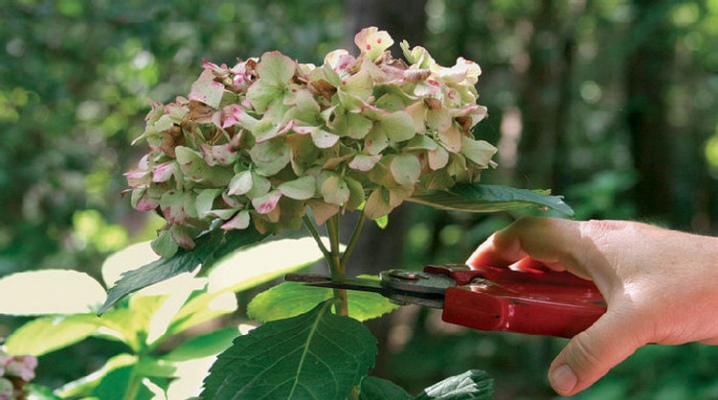
Hydrangea (Hydrangea) is loved by many gardeners for its beauty, variety of colors, flowering throughout the summer, easy care. The main thing that a plant needs is abundant watering (the name of a flower translates as "a vessel with water"). But in order to have a lot of large inflorescences, they need to be fed in a timely manner, and most importantly, they must be cut correctly and on time. It is pruning that gives decorativeness to different types and varieties of hydrangeas. Our article will tell you how to properly cut this or that form of a plant.
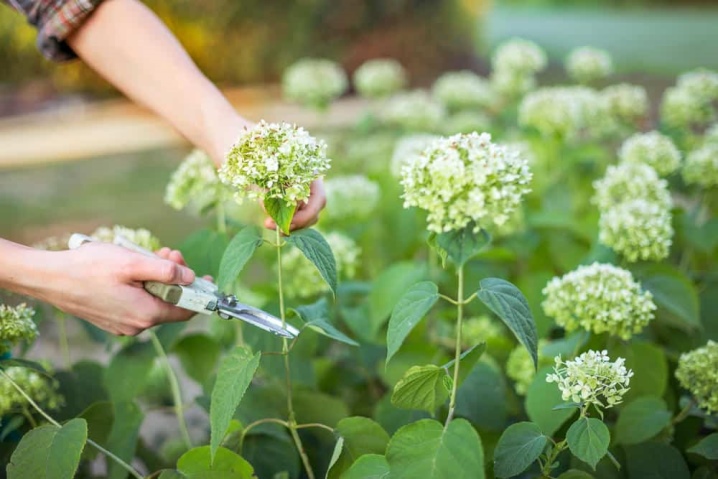
Optimal time of the year
In order to determine the most successful time for pruning a hydrangea, you need to know what species it belongs to (shrub, tree, liana). In addition, you need to take into account the varieties, which are divided into two groups according to the observance of the rules for pruning.
The first group includes hydrangeas that bloom on last year's shoots. These are the following varieties:
- oak-leaved;
- large-leaved;
- serrated;
- hydrangea Sargent (Sargent);
- petiolate.
Here are some examples of this group: Expression, Ever Peppermint, Endless Summer, You & Me.

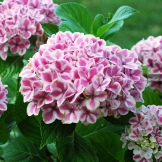
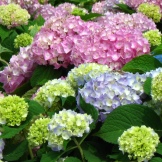
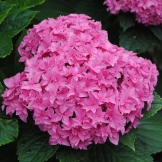
Hydrangeas of the second group form buds on young shoots that have grown in the current year. These are treelike and paniculate subspecies, represented by the following varieties: Dart's Little Dot, Pinky Winky, Hayes Starburst, Annabelle and many others.
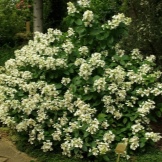
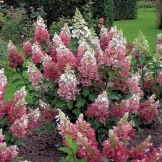
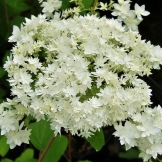
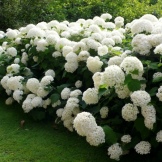
Plants of the first group are cleaned in the spring, when the buds begin to swell. Previously, this cannot be done, because the buds will indicate the place of origin of new branches. Whether it will be in March or April depends on the climatic zone and the current weather. For example, in the southern latitudes, the middle lane, where new shoots grow faster, the hydrangea is cleaned more thoroughly. Otherwise, instead of flowers, green mass will grow.
In the northern regions, beyond the Urals, in Siberia, where growth is slow, the pruning is carried out moderately. Some growers believe that large-leaved hydrangea does not need to be cut off in spring. Or make only light sanitary pruning.
And for the varieties of the second group, the formation of young shoots is important. Therefore, in the spring, they cut off the old, growing inward, diseased branches. A maximum of 3 pairs of kidneys are left on healthy processes. If the procedure is carried out correctly, an shoot with a lush inflorescence at the end will form from each bud by the summer.
It is impossible to tighten with pruning, otherwise the flower will not have time to ripen and prepare for frost. But throughout the summer, sanitary pruning must be done. If in June you find that the bush has grown a lot, extra young shoots have grown, then they need to be cut off without regret.
But it is better to do this after flowering. To do this, cut the branch by 1/3 at the nearest internode.

In the fall, the plant needs pruning and preparation for winter. Many lovers of this flower say that they do not remove the flower caps after they have faded. In winter, they look very beautiful against the background of snow. But with a large amount of it, it will put pressure on this flower herbarium and can break thin branches. Before preparing the plant for hibernation, branches growing inward are removed from the trees. In adult shrubs, trees, lianas, excess shoots are shortened.
In general, in autumn it is very convenient to form a crown, since the plant is in a state of "half-sleep" - juice will not be released abundantly, the shape of the plant, diseased, extra and dried branches are better visible. And flower growers have more time in the fall.
Thus, for pruning, the most appropriate time can be called spring and autumn, but summer sanitization will not harm the plant... And the result will be a lush crown, rejuvenation of the bush, an increase in the number and size of flowers.
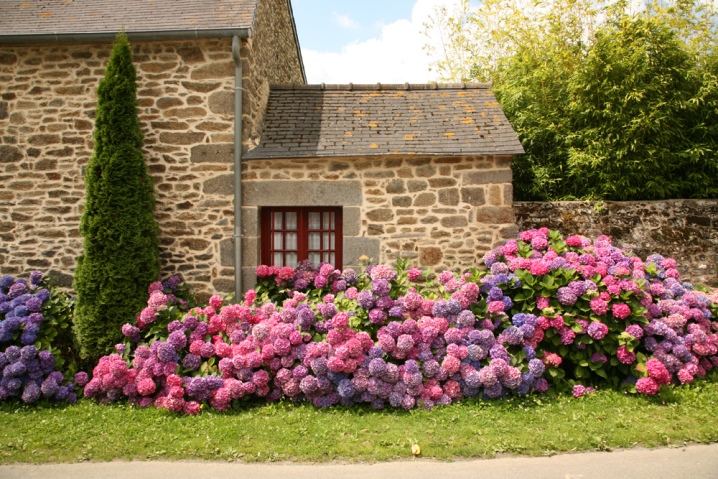
Types of pruning
Many hydrangea lovers do not cut their pet at all. But over time, such a plant will take on an ugly appearance, the buds will become smaller, due to the large number of shoots, flowers will stop forming altogether. To avoid these problems, and carry out pruning.
Based on the functions, there are 4 types of trimming: sanitary, shaping, stimulating, rejuvenating. If necessary, they are combined or carried out separately.
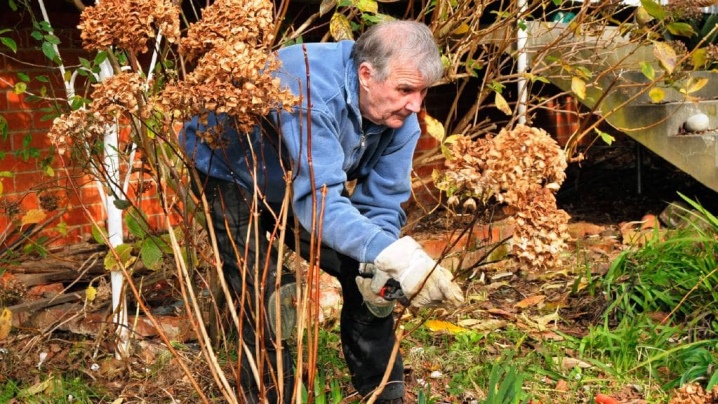
Sanitary
To get rid of dried, old, sick, crooked and unnecessary shoots, they carry out sanitary pruning. This is what you need to do in early spring. Indeed, during the winter, the branches could freeze, break from the weight of the snow. After cutting, it is worthwhile to carefully examine the bush (tree) again: if there are branches that grow inside the crown, then they also need to be cut off.
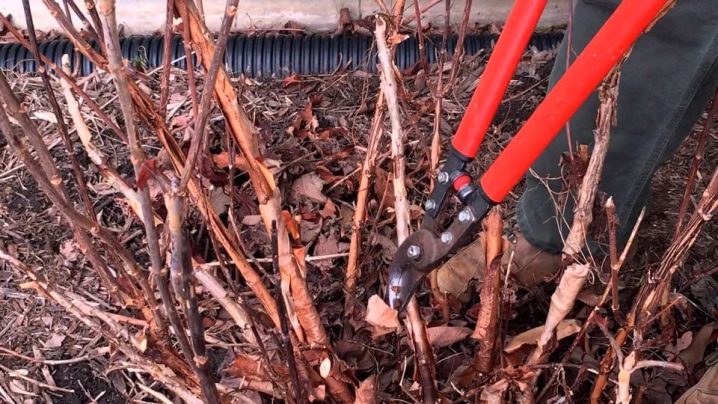
Formative
They begin to form a bush for 2-3 years. In the first year, the plant adapts and forms a root system. But then, to give it the desired shape, stimulate the growth of strong branches, distribute the inflorescences throughout the crown, and make a formative pruning. In the spring, while there is no green mass, skeletal branches and buds are clearly visible, from which shoots will grow. It is during this period that last year's growth is reduced by 1/5 - 1/3 of the length, leaving 2-3 buds. It is important to get rid of the weak branches and leave the strong ones pointing outward.
To organize the formation correctly, you need to take into account the specific features.
- In large-leaved hydrangea, faded buds are cut off, leaving young non-flowering growths.
- A tree is often formed from the paniculate variety, removing weak and inward growing branches. To form strong branches on a tree, they are shortened by only 1-2 buds. If at the planting site I would like to see a shrub, then the seedling is buried, giving the opportunity to grow new shoots from the ground.
- Treelike hydrangeas also begin to form in 2-3 years. In the 2nd year, the shoots are cut so that 3-4 buds remain. The main task is to form skeletal branches. And only a year later they begin to form the cap of the tree.
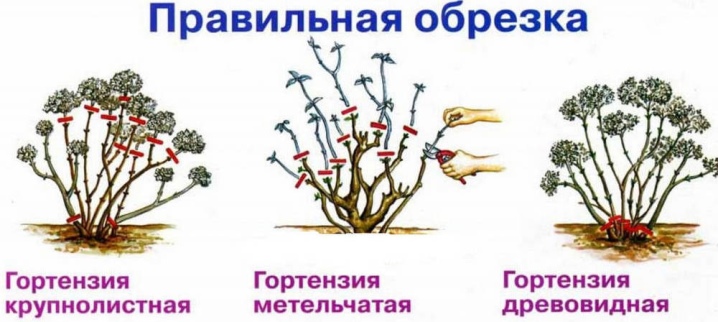
Stimulating
Regulatory (stimulating) pruning is designed to ensure abundant flowering. It is held annually starting from the third year. Time may coincide with sanitary pruning. In last year's shoots, part of the branches is removed above the first strong inflorescence. AND here the grower must solve a small problem for himself: active pruning of shoots will lead to abundant flowering, but the size of the plant will be greatly reduced... If there is no desire to greatly reduce the bush, then you need to cut off the shoots by no more than a third.
Stimulation leads to a large number of large flowers, which, with their weight, can break branches. It is necessary to use supports and a garter of such plants.
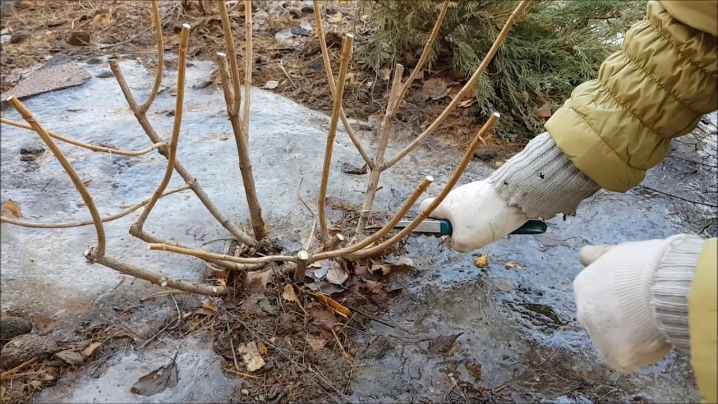
Rejuvenating
Cardinal rejuvenation is pruning a plant under a stump. It is carried out in cases where the hydrangea has suffered from diseases, mechanical damage, thickening, pests. With this type of pruning, perennial wood is cut at a height of 0.5-0.8 m, leaving young shoots. The cut is made with a hacksaw, covering it with garden pitch. The next year there will be no flowers, but the plant will grow a young crown, which can be easily formed in the desired shape.

Required tools and fixtures
Not many tools are needed to keep the plant looking good. But they must meet the following requirements.
- Be as sharp as possible to cut, not crush branches.
- Be safe and easy to use.
- Be lightweight but made of durable materials.
- It is better to use the narrowed ends of the blades to provide access to the depth of the bush.
- Instrument handles should be brightly colored anti-slip braids. It will be easier to find such a tool in the grass.
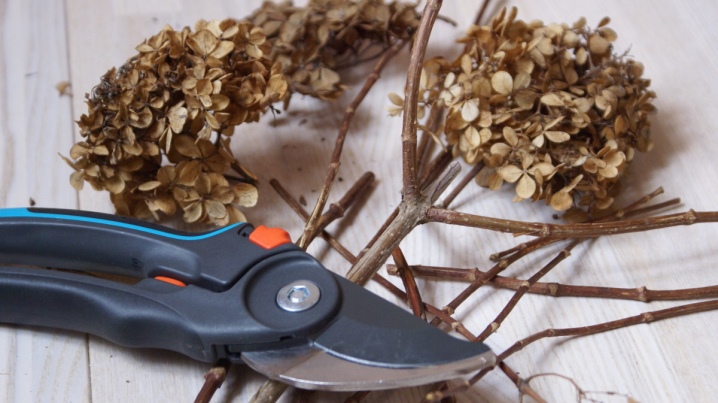
What instruments are we talking about?
- Secateurs. For hydrangeas, classic pruning shears with a curved blade - beak are suitable.But you can get a florist's tool for cutting flowers, as well as a pruner for pruning thorny plants - it will help you grab the cut flower, protecting your hands.
- Loppers will help not only in sanitary, but also in anti-aging pruning. They have long handles, which is convenient for thinning the plant. It is an indispensable tool for working at height or in the depth of the crown.
- Garden saws used for cutting thick branches and trunks. Garden hand saws work best on dry wood, although they will cut through live branches. But electric and chainsaws are used only on dry wood.
- Garden knives may also be needed: for removing irregularities, damaged bark, cutting a flower. There are several varieties of garden knives. For hydrangeas, trimming is suitable.
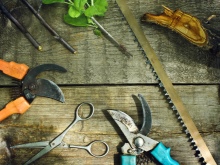
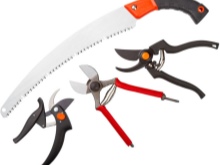
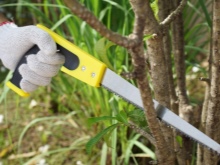
Except for tools. a florist will need:
- gloves;
- safety glasses for sanitary work;
- supports and harnesses for tying;
- garden pitch and coal for covering the cuts.

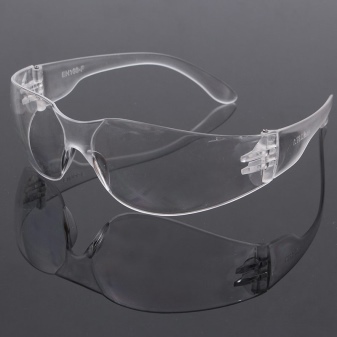
How to prune different types of hydrangeas?
In our country, paniculate, large-leaved (garden) and tree-like varieties are most often found. We will talk in more detail about how to properly prune a plant.
Tree-like
This variety is an ornamental shrub with lush flower heads. It is from this variety that it is recommended to start growing hydrangea for beginner growers, since it is not difficult to grow it, it is adapted to severe winters, tolerates direct sunlight and partial shade, and blooms from mid-summer to mid-autumn, delighting with flowers on the shoots of this year.
Professionals and amateurs agree that in the first 3-4 years only diseased or damaged branches should be pruned from the plant. In the fall, it is enough to cut off only the inflorescences of this variety. In the spring, the work front is much more:
- sanitary pruning, removal of processes growing inside the crown;
- pruning of one-year-old branches, on which 3-5 buds are left (they are the ones that will give the flowers of the current year);
- thinning, prevention of thickening;
- removing old branches on an adult plant.
Below is a diagram of the refinement of a tree hydrangea, depending on the season.
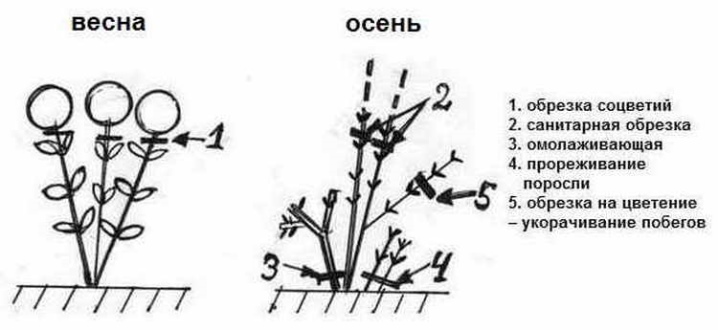
Paniculata
Incredibly beautiful cone-shaped buds shower paniculate varieties. They come in small flowers or large ones. On the branches of the current season, white inflorescences grow, which gradually turn into pale pink, and later - into bright pink. It is for this that the paniculate variety is so fond of. These varieties bloom in July-October.
To keep the cones large, the inflorescences are cut off after flowering. (immediately or in the fall). If this is not done, the inflorescences will become small, and the bush will thicken.
Pruning is carried out both for the bush form and for the standard tree.
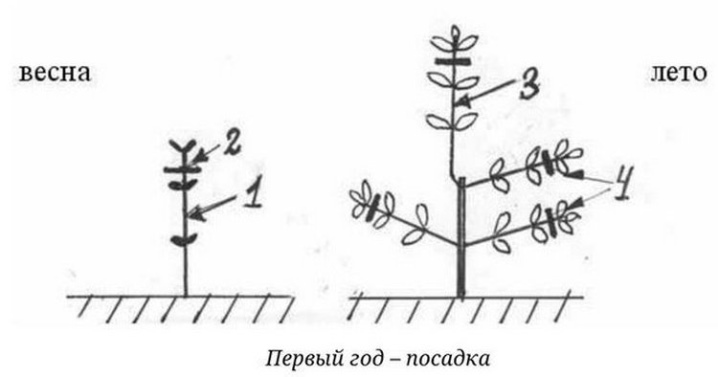
To create a lush bush from the recessed neck, allow new shoots to grow. The next year, these shoots are shortened, leaving up to 3 pairs of buds. Zero and weak shoots must be cut off. This species is well suited as a hedge, which will not only be a protective, but also a beautiful barrier. It is on such a plant that it is most convenient for beginner growers to practice.
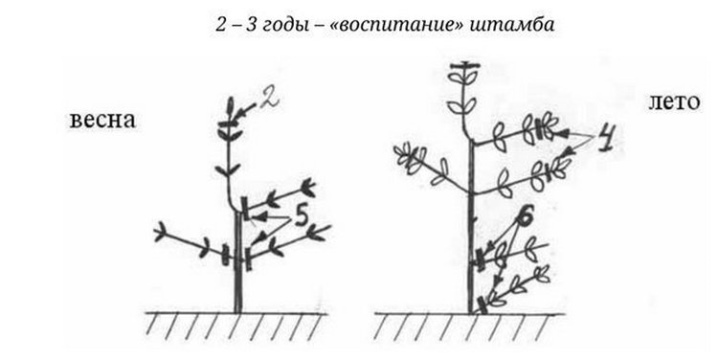
More experienced growers can form a bush with a raised crown:
- old and unnecessary branches are removed from a 3-year-old plant;
- leave no more than 5 shoots that grow at an angle of 60º from the ground;
- supports are installed under them parallel to the branches and tied up;
- every year, new shoots are removed in an annular flow, leaving only 2-3 apical buds;
- next year, new branches will go into growth, and last year's side ones are cut into a ring;
- from spring to winter, all shoots are removed on the central shoot, leaving only 2-3 apical shoots.
In this scheme, the plant is pruned until the crown grows to the desired height.
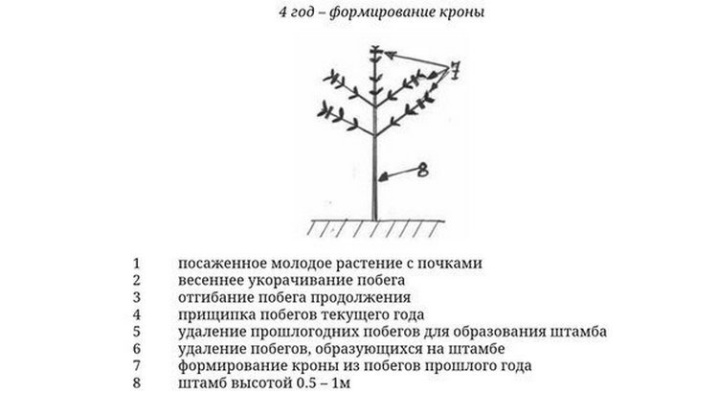
A standard tree is obtained as follows:
- cut off all shoots into a ring, except for the strongest, growing vertically;
- tie it to the support;
- pinch the lateral shoots formed in summer, but do not remove (they will serve to feed the stem);
- the next year, cut these side branches into a ring;
- upon reaching 0.5-1.5 m in height, the trunk begins to form a crown, cutting off the top of the tree and stimulating its branching.
It looks schematically as follows.
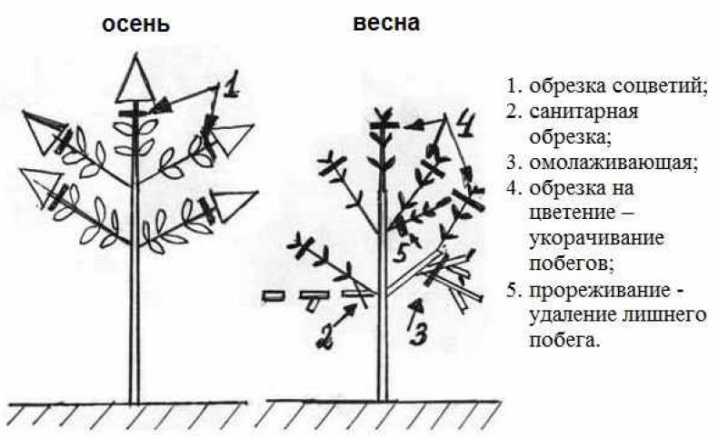
Throughout the entire growth, it is necessary to remove the young shoots that emerge from the roots of the plant. Also cut off the faded inflorescences, along with the branches on which they grew, up to the first pair of buds. Such pruning is the key to abundant flowering for the next year.
To thicken the stem, the lateral shoots are still pinched, and the next year they are cut off along the annular influx.
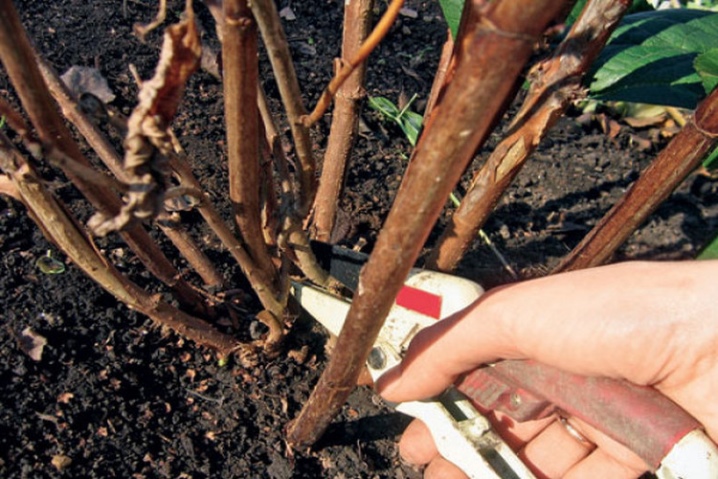
Large-leaved
The large-leaved garden hydrangea is considered the most capricious, but its blue, blue, red, snow-white flowers are worth the effort put into the plant. If pruned incorrectly, hydrangea may not bloom, therefore:
- in the spring, they carry out sanitary pruning, leaving last year's shoots, on the upper third of which there are autumn buds;
- old shoots are removed by 1⁄4;
- fight thickening by removing lateral and skeletal branches;
- every 4 years the bush is rejuvenated, leaving 30-40 cm from the ground, but it is advised to do this in the fall;
- with the onset of cold weather, faded flowers are removed.
The diagram below shows the scope of work that needs to be done with garden hydrangea in spring and autumn in terms of pruning.
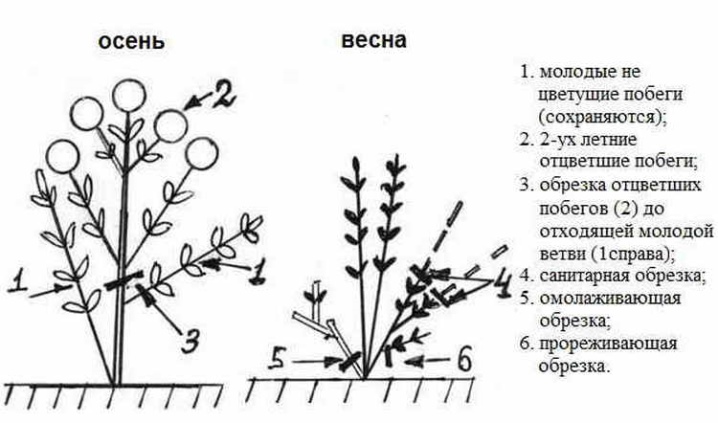
Helpful hints
To avoid mistakes in growing such a beautiful plant, use the following tips.
- Do not prune the hydrangea for the first 2 years.
- Do not pick off branches - just cut them off with a sharp and clean tool. Treat all cuts, split hemp with garden pitch or chopped coal.
- You need to work in dry weather, so as not to bring the fungus to wet sections. The cut is made obliquely, departing from the kidneys by 2-3 cm.
- If the bush is large and healthy, then thinning is carried out gradually, in 2-3 years.
- If the buds are already visible in the spring, but the weather is still cold, then it is worth waiting for the warming, and only then pruning.
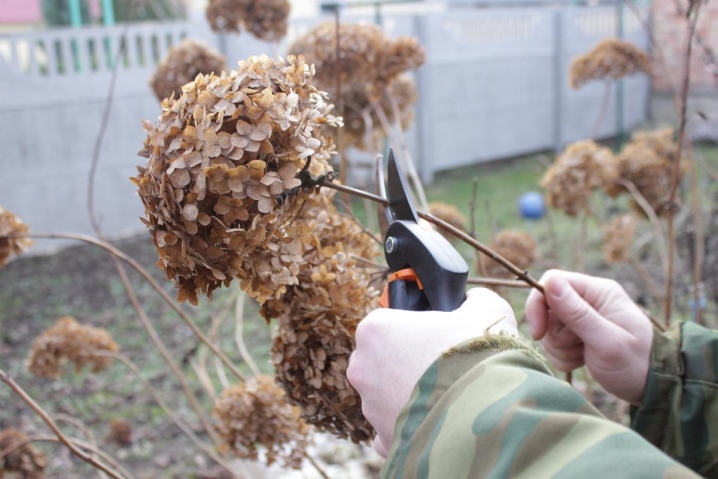
Follow-up care
In addition to pruning, hydrangeas need to be fed and watered in a timely manner. After spring pruning, the soil is mulched with compost, peat or humus. In the summer, you can feed with a solution of 1 part chicken manure and 10 parts water, or buy special fertilizers for hydrangeas. By the way, in stores you can also buy drugs to change the color of its buds.
After the autumn pruning, the garden hydrangea must be covered for the winter, but it is not necessary to cover the paniculate and tree-like hydrangea - it all depends on the climate of the place of its growth.
For information on how to properly trim hydrangea, see the next video.



































































The comment was sent successfully.